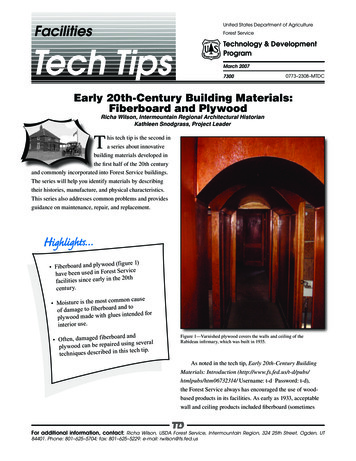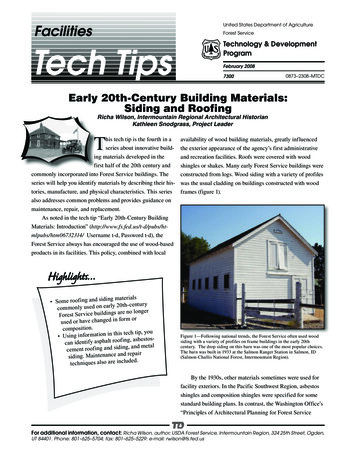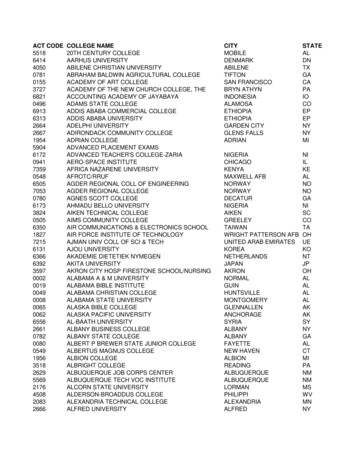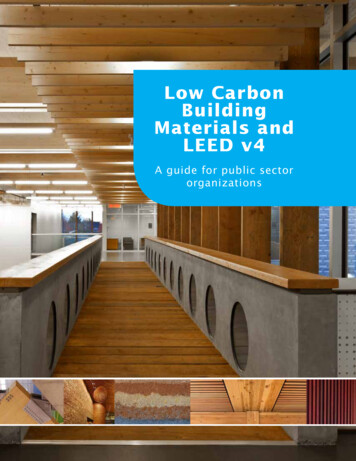
Transcription
FacilitiesUnited States Department of AgricultureForest ServiceTechnology & DevelopmentProgramMarch 200773000773–2308–MTDCEarly 20th-Century Building Materials:Fiberboard and PlywoodRicha Wilson, Intermountain Regional Architectural HistorianKathleen Snodgrass, Project LeaderThis tech tip is the second ina series about innovativebuilding materials developed inthe first half of the 20th centuryand commonly incorporated into Forest Service buildings.The series will help you identify materials by describingtheir histories, manufacture, and physical characteristics.This series also addresses common problems and providesguidance on maintenance, repair, and replacement.(fig ure 1) Fiberboard and ply woodServicehave been used in Forest20thfacilities since early in thecentur y.mon cause Moist ure is the most comd toanrdof damage to fiberboaended forintesply wood made with gluinterior use.oard and Of ten, damaged fiberbusing severaledairrepply wood can bes tech tip.techniques described in thiFigure 1—Varnished plywood covers the walls and ceiling of theRabideau infirmary, which was built in 1935.As noted in the tech tip, Early 20th-Century BuildingMaterials: Introduction 4/ Username: t-d Password: t-d),the Forest Service always has encouraged the use of woodbased products in its facilities. As early as 1933, acceptablewall and ceiling products included fiberboard (sometimesFor additional information, contact: Richa Wilson, USDA Forest Service, Intermountain Region, 324 25th Street, Ogden, UT84401. Phone: 801–625–5704; fax: 801–625–5229: e-mail: rwilson@fs.fed.us
referred to as rigid board, building board, or wallboard) andplywood. The Washington Office’s Improvement Handbook(1937) and Principles of Architectural Planning for ForestService Administrative Improvements (1938) noted thatcertain fiberboards were acceptable for use as insulation andon interior walls and ceilings. These included Masonite, NuWood, Du-X, and Fir-tex. To support the Forest Service’sgoal of using wood, fiberboards were favored as a finishmaterial, although they were also deemed suitable as a lath orbase for plaster finishes.Although the first American patent for fiberboard wasissued in 1858, fiberboard was not used widely until the1910s. During World War II, production increased becausefiberboard could be installed easily and quickly in temporarymilitary structures. The fiberboard industry also grew withand the binders, producing one smooth side and one sidethat was textured because it had been pressed against thescreen. The formed sheets were dried, trimmed, and, in somecases, finished with paint, enamel, paper, fabric, or glaze.Eventually, processes were developed to cover the panelswith wood veneer or plastic laminate.Because moisture was their primary enemy, fiberboardsoften were treated with waterproofing materials to retardrot and swelling. Asbestos, plaster of Paris, clay, turpentine,paraffin wax, or other materials were added to some mixes toimprove fire resistance and produce other desirable qualitiessuch as stiffness, hardness, smooth surfaces, increasedstrength, or durability.Fiberboard products were valued for ease of use,particularly by unskilled workers. For the Forest Service,the demand for housing after the war, particularly as aninterior finish. Some fiberboard materials were manufacturedfor exterior application, but they often performed poorly.Plywood, another wood-based product, gained favorbecause of technological advances during World Wars Iand II. It could be used for interior or exterior applicationsdepending on the type of adhesives used in the plywood. Bythe 1950s and 1960s, plywood and its cousin, particleboard,were preferred over fiberboard for many applications.this was particularly important when young, untrained menfrom the Civilian Conservation Corps constructed facilities.Unlike plaster walls and ceilings, fiberboard could be appliedquickly and required no drying time. The ImprovementHandbook (1937) indicated that, for reasons of economy,fiberboard was recommended as a finish in attics, basements,and closets even when other spaces were plastered.The joints between fiberboard panels could be treatedin several ways. The Principles of Architectural Planningfor Forest Service Administrative Improvements (1938)promoted a V-groove joint (figure 2), rather than the morecommon practice of covering joints with battens. TheNorthern Region Construction and Maintenance Handbook(1935) recommended that Masonite or plywood be installedhorizontally on walls, with a chair rail applied over thehorizontal seam between sheets. If these wallboardswere installed in dwellings, the handbook recommendedFiberboardFiberboard is a generic name for construction panelsmade of wood or vegetable fibers. Some are homogenousmaterials, while others are laminated sheets with fiber coresand surfaces of ground wood. The earliest fiberboard panelswere made with fibers from an array of materials includingjute, straw, sugar cane stalks, flax, hemp, grass, newspaper,and peanut shells. They were manufactured under namessuch as Fir-tex, Homasote, Masonite, Beaver Board, Feltex,Nu-Wood, and Upson Board.Wood has always been the most common fiber used infiberboard. Historic manufacturing processes varied, butmost required a pulping process that cooked or ground thewood to separate its fibers. The pulp was mixed with binderssuch as glue, asphalt, or resins and moved onto screens whereheavy pressure and heat squeezed out water and compressedthe fibers. This process bound the wood fibers to each other varnishing them. In other buildings, Masonite panels wereto be finished with light-colored calcimine. Calcimine is alow-cost, water-based paint (sometimes known as distemper)containing glue and coloring.Fiberboard is differentiated by density. Most historicfiberboard can be categorized as low-density (insulation)board, medium-density board, or hardboard.Low-Density FiberboardLow-density fiberboard was known as insulation boardbecause of its sound-deadening and thermal qualities. This
Figure 2—This section of page 24 of the Forest Service’s Principles of Architectural Planning for Forest Service Administrative Improvements (1938)explains acceptable uses of plywood, Masonite, Nu-Wood, and similar materials.lightweight, rigid product made of fibrous pulp was availablein sheets, planks, and tiles. Insulation board was best suitedfor interior applications because of its susceptibility to waterdamage.Insulation board could be installed on interior wallsand ceilings and painted or calcimined. Left unfinished, itsbrown face could be easily scored or cut to create interestingpatterns (figure 3), and then painted to provide an easilycleaned surface (figure 4). Sheets with beveled edges wereavailable and offered additional decorative properties.Sometimes insulation board, rather than traditional woodlath, was used to support plaster.While the thickness of insulation board ranged from 3 8to 1 inch, Forest Service guidebooks often recommended½-inch insulation board for facilities. Sheets were 4 to 8feet wide and could be up to 16 feet long. Panels used asinsulating lath under plaster typically measured 18 to 24inches wide and 48 inches long. Insulation board was securedto the building frame with adhesives, nails, screws, orpatented methods such as dropped metal grids for ceilings,the forerunner of the suspended ceilings found in manyoffices today.Early trade names for insulation board included Insulate,Fir-tex, and Nu-Wood–all of which were made from woodpulp. In 1921, a fiberboard was produced using bagasse, thedry pulp byproduct of sugar cane after the juice has beenextracted. This fiberboard was the first of many productsdeveloped by Celotex Co., which later produced acousticmaterials such as the perforated Acousti-Celotex Cane Tile.The first Masonite product, made in 1927, was a 7 16 -inchinsulation board that could be used as structural sheathing, sound insulation, and an interior wall surface. Plastercontaining no more than 10 percent lime could be applieddirectly to the board. Other early Masonite products includedbeveled tiles and planks and the Litecol board, which wasnearly white.Masonite Corp. used a unique pulping process. Insteadof cooking or grinding the wood chips, a machine ex-
Figure 3—This fiberboard ceiling in the Butte Falls Ranger Station (RogueRiver-Siskiyou National Forest, Pacific Northwest Region) has been carvedinto a decorative pattern. The ceiling is the natural brown color of the woodpulp from which it was manufactured.Figure 4—The fiberboard ceiling in the Fenn Ranger Station office (MooseCreek Ranger District, Nez Perce National Forest, Northern Region) hasbeen carved and painted.ploded them with such force that the wood fibers separated.Masonite Corp. later concentrated on producing its popularhardboard (see the Hardboard section).use, it was available as smooth, striated, or wood-texturedpanels and as beveled siding. Panels as large as 8 by 14 feeteliminated the need for battens or seams in most rooms.Homasote is still manufactured today.Beaver Board was a laminated sheet product inventedin 1903 and perfected with several patents in the 1910s. The1914 patent described a 3 16 -inch-thick board with an interiorlayer of ground wood covered by thin layers of cooked woodon each side to provide moisture resistance and strength. Oneside was finished with a thin layer of textured ground woodfor decorative purposes. Used through the 1920s, this versionof Beaver Board came in 32- and 48-inch widths. The backwas stamped with the company’s logo and instructions, whilethe front had a pebbled finish that could be painted, stained,or left natural. To allow for expansion, panels had to beinstalled 1 8 inch apart. Decorative battens typically coveredthe gap.Upson Board was another laminated fiberboard with onetextured side, similar in appearance to Beaver Board. Theprimary difference was that the back of Upson Board wasnot stamped with the brand name. Instead, its center layerwas dyed blue, making it readily identifiable. Three widths(32, 48, and 64 inches) and seven lengths were available. In1920, the manufacturer patented the Upson Self-ClinchingFastener, a five-pronged steel fastener. These were nailed tostuds and the fiberboard panels were pressed onto the prongs,which held them in place.For several decades, medium-density fiberboardsremained popular even as their manufacturing processesand ingredients changed. In 1928, CertainTeed Corp. boughtBeaver Board Co. and continued to produce Beaver Boardunder that trade name until the early 1940s. Upson Co. usedthe name briefly after buying the Beaver Board factory fromCertainTeed in 1955. They continued to make Upson Board,Beaver Universal Fiberboard, and Beaver Fiberboard. Theoriginal Upson Co. closed in 1984.Medium-Density FiberboardHomasote, Beaver Board, and Upson Board weremedium-density fiberboards promoted for use in a varietyof applications. Homasote, introduced in 1916, was ahomogenous material made of recycled newspapers (thesource of its gray color) and petroleum wax. Touted as aninsulation and structural board for interior and exterior HardboardMost historic hardboard was 1 8 to 5 16 inch thick,although two boards could be glued together to make a panelthat was more rigid. Masonite Corp. introduced its firsthardboard in the early 1930s. The Presdwood hardboard,from 1 10 to 5 16 inch thick, was used for interior finishes and
as battens over other Masonite products. Panels could benailed or glued vertically or horizontally, then painted orwallpapered. A more durable product known as TemperedPresdwood was introduced in 1931. Often, it was screwedto studs and its joints covered with decorative battens.Temprtile, a popular choice for bathrooms and kitchens, wasa Masonite water-resistant hardboard embossed to look like4- by 4-inch tiles (figure 5).Masonite and other hardboards became staples ofpremanufactured housing and lined the interiors of morethan 150,000 Quonset huts during World War II (figure6). By the 1950s, hardboard siding was available in panel,shiplap, shingle, and board-and-batten styles. Optionalfeatures included factory-applied primers, vented mountingstrips, and several textures. Another 1950s Masonite productwas a gray, wood-grained interior wall panel known as MistyWalnut. Masonite’s Royalcote, with its polished and durablefaux wood finish, also proved popular.Figure 6—Masonite was often used to finish the interiors of the Quonsethuts that the Forest Service acquired from the military after World War II.This Quonset hut is now used for storage at the Duck Creek AdministrativeSite (Juneau Ranger District, Tongass National Forest, Alaska Region).Identification of Fiberboard PanelsFiberboard usually can be identified by its brown orgray color and homogenous appearance. If fiberboard ispainted, look for clues such as joint moldings, beveled joints,or scoring. Check areas such as basement stairs and atticswhere unpainted surfaces may be exposed. You may be ableto see cross sections where the fiberboard has been brokenoff or cut for electrical boxes, plumbing lines, or mechanicalequipment.When tapped, insulation board will sound somewhathollow and softer than gypsum board or plaster, althoughnumerous layers of paint may minimize this difference.If you can’t tell whether a surface is fiberboard using themethods described above, choose a concealed area (a closetor under the eaves, for example) and drill a small hole,preferably with a hand drill. This will help you determine thethickness of the board and will provide drill shavings thatcan be examined for color, texture, and material.Maintenance and Repair ofFiberboardFigure 5—Temprtile, a hardboard product embossed to resemble tile,was used as a water-resistant wainscot in the cook’s bathroom at the FennRanger Station.Fiberboards share several problems, but susceptibilityto moisture damage is the most common. Insulation board ismore susceptible to moisture damage than denser fiberboard,although all fiberboard products can warp or rot in humid
areas or when water has penetrated them. Keep fiberboardsdry. Clean them with a damp cloth and dry excess moisturewith a clean cloth. Don’t use soap or harsh detergents unlessthe surface is covered with paint or another protective finish.Because insulation boards are relatively soft, they canbe dented or punctured easily. Hardboard is brittle. In anycase, unprotected edges and corners of fiberboard productsare especially vulnerable. Consider installing plastic cornerguards, door bumpers, and other protective devices. Arrangefurniture and place fixtures in a way that will minimizecontact with fiberboard walls.If laminated layers of wallboard are separating, theycan be reattached by applying or injecting wheat paste, anadhesive commonly used in conservation work because thechanges can be undone relatively easily. You can make yourAll fiberboards expand and contract with humidity andshould be installed with gaps between the panels. Gaps thatare too small can cause the board to warp or the finish tofail. If the fiberboards were installed with too small a gap,trim the fiberboards carefully to provide enough space forexpansion.If you can remove a warped fiberboard panel withoutdamage, wet it slightly, apply pressure to flatten it, and allowit to dry before reinstalling it. Use small, inconspicuous nailsor screws when reattaching sagging fiberboard on ceilings.If the fiberboard is too damaged to repair, replace it.Fiberboards are still made today. Some modern productsmatch the size and appearance of some historic products.Another option is to reuse fiberboard from a less visiblearea (such as a closet or attic) or from buildings that areown paste with wheat starch from a natural foods store (seerecipe below), although it may be easier to buy wheat pastefrom an art or archival products supplier. If the wallboard’sfibers are separating: Thin wheat paste with water. Use the thinned paste to soak the area.This approach is feasible for small areas. Extensive damagemay require replacing the wallboard panel.not historically significant. Substitute materials, such asgypsum board, may be acceptable replacements for paintedwallboard. Be sure to consult with your heritage staff andState Historic Preservation Office before removing orreplacing any materials.PlywoodWheat PasteRecipesMix 1 tablespoon of wheat starch with 5tablespoons of distilled waterMicrowave on “High” for 20 to 30 seconds,then stir.Repeat several times until the paste is stiffand translucent.Let the paste cool before using. Most people are familiar with plywood, a laminatedproduct consisting of thin layers of wood glued together withalternating perpendicular grain orientations. Until about1919, plywood also was known as scale board, pasted wood,and built-up wood. Plywood is lighter and stronger than solidwood, is more flexible, and has a high shear value.In the nineteenth century, plywood was made of thinstrips of saw-cut wood and was typically used for furnitureand door panels. The plywood industry began to flourishafter rotary cutters were invented in the 1890s. Thesemachines cut large, thin sheets of wood by rotating a logagainst a knife. This advance permitted the development oflarger and stronger sheets of plywood.Despite considerable attention, plywood productionwas rather lackluster in the early 1900s. This changedduring World War I when the product was improved andused to construct lightweight aircraft. With these advances,public perception shifted. Plywood, no longer seen as acheap substitute, became valued in a variety of buildingapplications.
The Forest Service’s Forest Products Laboratoryis credited with significant contributions to plywoodtechnology. The lab began testing plywood sheathing in thelate 1920s and successfully erected an experimental stressedskin plywood house in 1935. Two years later, the ForestProducts Laboratory built the first prefabricated low-costplywood house.A series of other firsts emerged for the laminated sheetmaterial in the 1930s. These included the introduction of thefirst water-resistant plywood for exterior use (1934), the firstcommercially prefabricated house with exterior plywood(1936), and the design of the plywood Dri-Bilt house (1938)that featured PlyScord subfloors and sheathing, PlyWallceilings and walls, PlyPanel built-ins, and PlyShield sidingin over a million low-cost homes. Plywood had become anaccepted building material.The first standard-size sheets of plywood were 3 by6 feet, but by the early 1930s, 4- by 8-foot sheets werestandard. They typically had an odd number of layers,although plywood with even numbers of layers has beenproduced since World War II. As the techniques formanufacturing plywood were perfected, manufacturersincreasingly offered plywood with decorative veneers andfinishes. Some were made with striations or V-shapedgrooves carved into them. Others were embossed orprefinished in several colors.Figure 8—These plywood cabinets, constructed by the CCC in thecookhouse at the Fenn Ranger Station, are on the kitchen side of the servingcounter. In this structure, cabinets visible only to the cook are plywood,while cabinets visible from the dining room are constructed of solid lumber.Originally limited to door panels, walls, and ceilings(figure 7), plywood eventually was accepted in otherapplications, such as sheathing and cabinetry (figure 8), andexterior finished surfaces.IdentificationThe most obvious characteristics of plywood includeits wood grain, laminated layers, and the football-shapedplugs used as patches when defects are removed from a layer.Often, these plugs are visible even after the plywood hasbeen painted.Plywood has been available with interior-, exterior-,or marine-grade glues since the late 1930s. Interior gluesremain the cheapest, but marine glues provide the mostresistance to delamination
Hardboard Most historic hardboard was 1 8 to 5 16 inch thick, although two boards could be glued together to make a panel that was more rigid. Masonite Corp. introduced its first hardboard in the early 930s. The Presdwood hardboard, from 1 1











